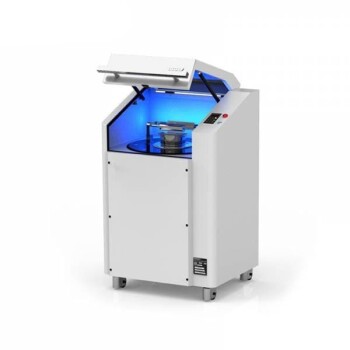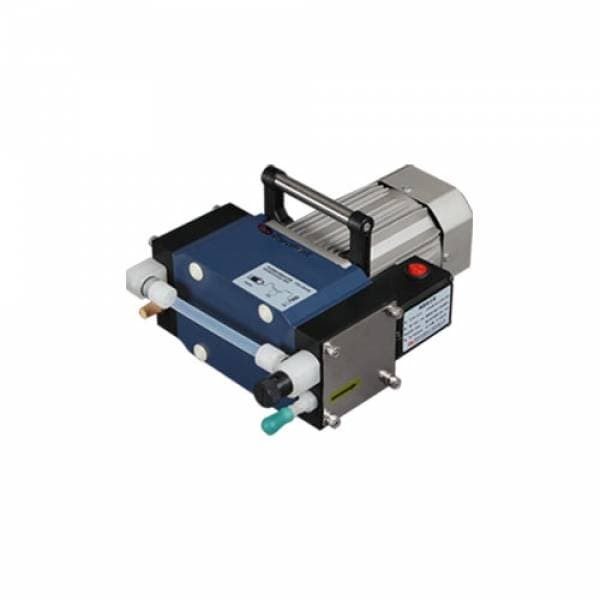
vacuum pump & cold trap chiller
Laboratory Diaphragm Vacuum Pump Lab Vacuum Pump
Item Number : LE301
Price varies based on specs and customizations
- Motor
- new low temperature motor
- Structure
- New designed structure

Shipping:
Contact us to get shipping details Enjoy On-time Dispatch Guarantee.
Application
Diaphragm Vacuum Pump provides negative pressure condition for processes of evaporation, distillation, crystallization, drying, sublimation, reduced pressure filtration etc.
Diaphragm Vacuum Pump can be used to extract a variety of highly toxic, flammable and explosive, strong acid, and alkali sample.
Detail & Parts

Anti-corrosion Anti-fatigue;Small size and environmental protection;Ultimate pressure up to 8mbar;Maximum pumping rate up to 25L/min


Silencer;Effectively reduce noise.

Vacuum regulator;The vacuum index can be adjusted according to the experimental needs.

The valve plate is made of imported PEEK material;Durable and corrosion resistant;Filter: prevent solid particles and liquid water from entering the pump body;Diaphragm - Teflon material; effectively prevent gas corrosion.
Advantages
- After 1500 hours of fatigue testing, our Diaphragm Vacuum Pump can work stably.
- Using a new low temperature motor, the pump body temperature is low.
- New designed structure improve the vacuum and pumping rate significantly.
- A substitute for water circulating vacuum pump and rotary vane vacuum pump.
- No water consumption, environmental protection and cleanliness.
- All parts that contacting gases are made of PTFE + FV rubber with chemical resistance.
- Valve plate adopts imported materials.
- Small size, light weight, easy to move, save space.
- Easy maintenance and repair
Technical specifications
| power | parameter |
| Motor power (W) | 180 |
| Power supply | 220-240V~, 50Hz |
| Suction diameter (mm) | ∅10×∅6 |
| Maximum vacuum (MPa) / | 0.0992/8 |
| Ultimate pressure (mbar) | |
| Maximum pumping rate (L/min) | 25 |
| Dimensions (mm) | 310W×225D×168H |
| Weight (Kg) | 10 |
| Operating ambient temperature (°C) | 5~35 |
| Ambient relative humidity (%) | ≤ 70 |
| Enclosure protection class | IP20 |
| Anti-pollution | level 2 |
| Inlet and outlet nozzle connection hose specifications: (outer diameter × inner diameter) (mm) Rubber hose: ∅12×∅6 | |
Warnings
Operator safety is the top important issue! Please operate the equipment with cautions. Working with inflammable& explosive or toxic gases is very dangerous, operators must take all necessary precautions before starting the equipment. Working with positive pressure inside the reactors or chambers is dangerous, operator must fellow the safety procedures strictly. Extra caution must also be taken when operating with air-reactive materials, especially under vacuum. A leak can draw air into the apparatus and cause a violent reaction to occur.
Designed for You
KinTek provide deep custom made service and equipment to worldwide customers, our specialized teamwork and rich experienced engineers are capable to undertake the custom tailoring hardware and software equipment requirements, and help our customer to build up the exclusive and personalized equipment and solution!
Would you please drop your ideas to us, our engineers are ready for you now!
FAQ
What Is Laboratory Vacuum Pump?
What Is The Purpose Of Vacuum Pump In Laboratory?
What Is The Use Of Pump In Laboratory?
What Is Used In A Laboratory To Form And Contain A Vacuum?
How Does A Laboratory Vacuum Pump Work?
4.8
out of
5
Our lab needed a reliable vacuum pump and the Diaphragm Vacuum Pump from KINTEK SOLUTION fit the bill perfectly. It's easy to maintain, and we've had it running for thousands of hours without any issues.
4.9
out of
5
I was impressed with the Diaphragm Vacuum Pump's chemical resistance. It handles all our acidic and corrosive substances without a hitch. A great choice for our lab's needs.
4.7
out of
5
The Diaphragm Vacuum Pump is a lifesaver in our lab. It's so quiet that we can run it without disturbing our experiments. Plus, it's incredibly easy to use.
4.6
out of
5
The Diaphragm Vacuum Pump is a great value for the price. It's well-built and has all the features we need in a lab vacuum pump. Highly recommended!
4.8
out of
5
The Diaphragm Vacuum Pump has exceeded our expectations. It's powerful, reliable, and incredibly easy to maintain. We're very happy with our purchase.
4.9
out of
5
The Diaphragm Vacuum Pump is a game-changer in our lab. It's so efficient that we've seen a significant reduction in our operating costs. A must-have for any lab looking to save money.
4.7
out of
5
The Diaphragm Vacuum Pump is a breeze to use. It's intuitive and requires minimal maintenance. Our lab technicians love it!
4.6
out of
5
The Diaphragm Vacuum Pump is a solid investment. It's durable and has held up well in our demanding lab environment. We're confident it will serve us for years to come.
4.8
out of
5
The Diaphragm Vacuum Pump is a technological marvel. It's incredibly advanced and has helped us streamline our lab processes. We're very impressed with its capabilities.
4.7
out of
5
The Diaphragm Vacuum Pump is a lifesaver. It's helped us improve the accuracy and efficiency of our experiments. We're very grateful to have it in our lab.
4.9
out of
5
The Diaphragm Vacuum Pump is a game-changer. It's so powerful and reliable that it's made our lab work so much easier. We highly recommend it!
4.6
out of
5
The Diaphragm Vacuum Pump is a great value for the money. It's affordable and has all the features we need in a lab vacuum pump. We're very happy with our purchase.
4.8
out of
5
The Diaphragm Vacuum Pump is a breeze to use. It's user-friendly and requires minimal maintenance. Our lab technicians love it!
4.9
out of
5
The Diaphragm Vacuum Pump is a solid investment. It's durable and has held up well in our demanding lab environment. We're confident it will serve us for years to come.
4.7
out of
5
The Diaphragm Vacuum Pump is a technological marvel. It's incredibly advanced and has helped us streamline our lab processes. We're very impressed with its capabilities.
4.6
out of
5
The Diaphragm Vacuum Pump is a lifesaver. It's helped us improve the accuracy and efficiency of our experiments. We're very grateful to have it in our lab.
4.8
out of
5
The Diaphragm Vacuum Pump is a game-changer. It's so powerful and reliable that it's made our lab work so much easier. We highly recommend it!
4.7
out of
5
The Diaphragm Vacuum Pump is a great value for the money. It's affordable and has all the features we need in a lab vacuum pump. We're very happy with our purchase.
REQUEST A QUOTE
Our professional team will reply to you within one business day. Please feel free to contact us!
Related Products
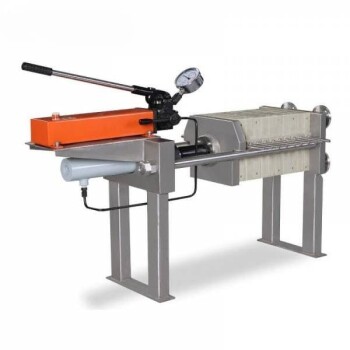
Hydraulic Diaphragm Lab Filter Press for Laboratory Filtration
Hydraulic diaphragm lab press filter is one type lab scale filter press, it takes small footprint, and higher pressing power.

Laboratory Benchtop Water Circulating Vacuum Pump for Lab Use
Need a water circulating vacuum pump for your lab or small-scale industry? Our Benchtop Water Circulating Vacuum Pump is perfect for evaporation, distillation, crystallization, and more.
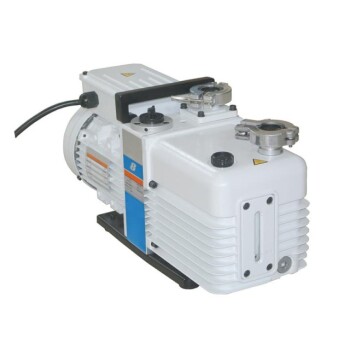
Laboratory Rotary Vane Vacuum Pump for Lab Use
Experience high vacuum pumping speed and stability with our UL-certified Rotary Vane Vacuum Pump. Two-shift gas ballast valve and dual oil protection. Easy maintenance and repair.
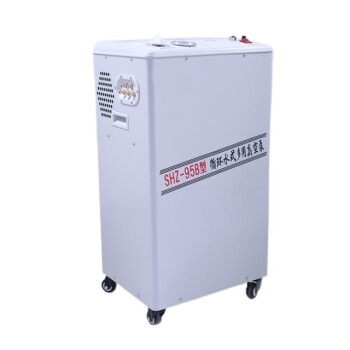
Laboratory Vertical Water Circulating Vacuum Pump for Lab Use
Looking for a reliable water circulating vacuum pump for your lab or small-scale industry? Check out our Vertical Water Circulating Vacuum Pump with five taps and a larger air sucking amount, perfect for evaporation, distillation, and more.

High Pressure Laboratory Vacuum Tube Furnace Quartz Tubular Furnace
KT-PTF High Pressure Tube Furnace: Compact split tube furnace with strong positive pressure resistance. Working temp up to 1100°C and pressure up to 15Mpa. Also works under controller atmosphere or high vacuum.

Laboratory Sterilizer Lab Autoclave Pulse Vacuum Lifting Sterilizer
The pulse vacuum lifting sterilizer is a state-of-the-art equipment for efficient and precise sterilization. It uses pulsating vacuum technology, customizable cycles, and a user-friendly design for easy operation and safety.
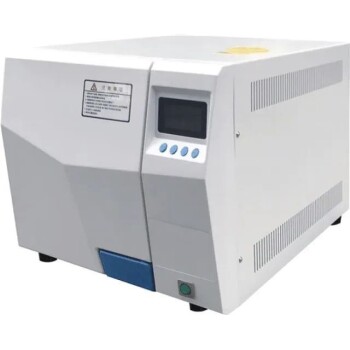
Laboratory Sterilizer Lab Autoclave Pulsating Vacuum Desktop Steam Sterilizer
The pulsating vacuum desktop steam sterilizer is a compact and reliable device used for rapid sterilization of medical, pharmaceutical, and research items.

Efficient split chamber CVD furnace with vacuum station for intuitive sample checking and quick cooling. Up to 1200℃ max temperature with accurate MFC mass flowmeter control.

Laboratory Vacuum Tilt Rotary Tube Furnace Rotating Tube Furnace
Discover the versatility of Laboratory Rotary Furnace: Ideal for calcination, drying, sintering, and high-temperature reactions. Adjustable rotating and tilting functions for optimal heating. Suitable for vacuum and controlled atmosphere environments. Learn more now!

Vacuum Hot Press Furnace Machine for Lamination and Heating
Experience clean and precise lamination with Vacuum Lamination Press. Perfect for wafer bonding, thin-film transformations, and LCP lamination. Order now!

1700℃ Controlled Atmosphere Furnace Nitrogen Inert Atmosphere Furnace
KT-17A Controlled atmosphere furnace: 1700℃ heating, vacuum sealing technology, PID temperature control, and versatile TFT smart touch screen controller for laboratory and industrial use.

CF KF Flange Vacuum Electrode Feedthrough Lead Sealing Assembly for Vacuum Systems
Discover high-vacuum CF/KF flange electrode feedthroughs, ideal for vacuum systems. Superior sealing, excellent conductivity, and customizable options.
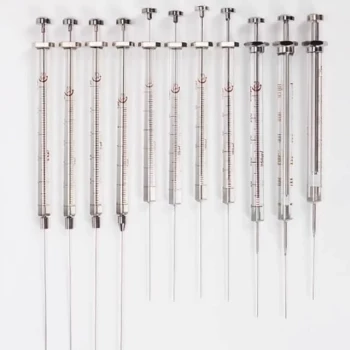
Lab Micro-Injector Liquid Phase Gas Chromatography Injection Plunger Needle
Precision-engineered for accurate sample introduction in gas chromatography, ensuring reliable and reproducible results.

Graphite Vacuum Furnace IGBT Experimental Graphitization Furnace
IGBT experimental graphitization furnace, a tailored solution for universities and research institutions, with high heating efficiency, user-friendliness, and precise temperature control.
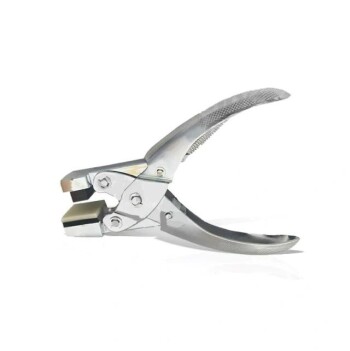
Professional Cutting Tools for Carbon Paper Cloth Diaphragm Copper Aluminum Foil and More
Professional tools for cutting lithium sheets, carbon paper, carbon cloth, separators, copper foil, aluminum foil, etc., with round and square shapes and different sizes of blades.
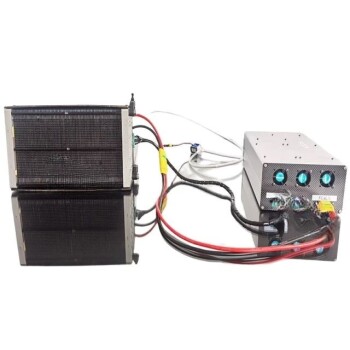
Hydrogen Fuel Cell Stack Battery Lab Equipment
A fuel cell stack is a modular, highly efficient way to generate electricity using hydrogen and oxygen through an electrochemical process. It can be used in various stationary and mobile applications as a clean and renewable energy source.

Vacuum Hot Press Furnace Heated Vacuum Press Machine Tube Furnace
Reduce forming pressure & shorten sintering time with Vacuum Tube Hot Press Furnace for high-density, fine-grain materials. Ideal for refractory metals.

Laboratory Quartz Tube Furnace Tubular RTP Heating Furnace
Get lightning-fast heating with our RTP Rapid Heating Tube Furnace. Designed for precise, high-speed heating and cooling with convenient sliding rail and TFT touch screen controller. Order now for ideal thermal processing!
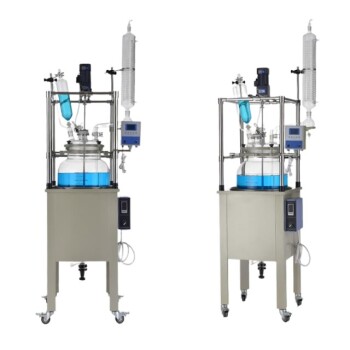
80-150L Single Jacketed Glass Reactor Vessel for Lab Use
Looking for a glass reactor system for your lab? Our 80-150L single glass reactor offers controlled temperature, speed, and mechanical functions for synthetic reactions, distillation, and more. With customizable options and tailored services, KinTek has you covered.
Related Articles

Distilling Liquids Using a Rotovap A Step-by-Step Guide
Distilling liquids is a process that has been used for centuries. The traditional method of distillation can be time-consuming and requires a lot of energy.

Discover The Benefits of Using A Rotary Evaporator
Rotary evaporators are essential laboratory equipment used in the process of separating solvents from samples. These devices work by evaporating the solvent from the sample under a reduced pressure and controlled temperature.

Step-by-Step Guide to Operating a Short Path Distillation Apparatus
Operating of Short Path Distillation and Precautions

Installation of Tube Furnace Fitting Tee
Mainly introduces the installation method of tube furnace fitting tee.

From Chemistry to Cooking The Versatility of Rotary Vacuum Evaporator
A rotary vacuum evaporator is a laboratory equipment that uses a rotating flask to remove solvents from a sample. It works by creating a vacuum in the system, which lowers the boiling point of the solvent and allows it to evaporate at lower temperatures.

Common Mistakes to Avoid When Using a Rotary Vacuum Evaporator
A rotary vacuum evaporator, also known as a rotovap, is a laboratory equipment used for distillation purposes. It is a highly efficient system used for the removal of solvents from samples under low pressure and low temperature.

CVD Systems Common Problems and How to Solve Them
Understanding the basics of CVD systems and their importance is crucial for optimizing the process and solving common problems encountered during operation.

How to Maximize Extraction Efficiency with a Rotary Evaporator
Rotary evaporation is a technique used to separate solvents from a sample through the removal of volatile components. It involves placing a sample in a round bottom flask and rotating it while under vacuum.

A Comparison of Rotovap Distillation and Other Distillation Technologies
Distillation is a separation technique used to purify liquids through heat application and vaporization. It is a crucial process in various industries such as the chemical, pharmaceutical, and food industries. There are various distillation technologies available, each with its unique advantages and disadvantages.

Comprehensive Overview of Cold Isostatic Pressing Services
Cold Isostatic Pressing (CIP) services play a crucial role in various industries, providing solutions for sterilization and compacting powders. These services offer a wide range of capabilities, ensuring the highest quality and efficiency.

Don't Let Overheating Ruin Your Experiment Use a Chiller for Your Rotavap
Chillers are essential laboratory equipment used to maintain a constant temperature during experiments. They are especially important when using a rotary evaporator (rotavap) to prevent overheating.

Advantages of Laboratory Circulating Water Vacuum Pumps
Explores the benefits of using laboratory circulating water vacuum pumps over traditional methods.
